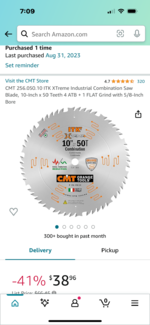I picked up a Rigid portable table saw a couple months ago. The price dropped, and it was only about $500, and I have needed a table saw for a multitude of things. I have used it for some construction work, repairs on my house and the like, but I'm also primarily going to use it for woodworking over the long run. I suspect the blade that came with it is not ideal...it may have a very slight warp, and I don't think it really cuts all that well in general.
So, I'm curious, what kind of blade would you guys recommend for woodwork? Mostly, I suspect I'll be cutting segments for segmented bowls and segmented pens. Maybe other segmented pieces (I'm into making Christmas ornaments right now, and I could see making a bunch with segmented blanks!) Anyway, I don't know a whole lot about saw blades. I also have a 10" miter saw, which I did replace the blade on (which was an improvement). I have a higher tooth count on that one, and I generally take my time with cuts, but I'm curious what kind of blade you guys would generally recommend for that as well.
Also, curious...do you guys generally use a different kind of blade for ripping vs. crosscutting on a table saw? With my bandsaw I use a lower tooth count, wider blade for ripping. Wondering if it matters the same on a tablesaw...the speed of the blade is so much higher with the table saw, and if I ripped, it likely wouldn't be particularly long boards (this thing doesn't have that much of a table.)
So, I'm curious, what kind of blade would you guys recommend for woodwork? Mostly, I suspect I'll be cutting segments for segmented bowls and segmented pens. Maybe other segmented pieces (I'm into making Christmas ornaments right now, and I could see making a bunch with segmented blanks!) Anyway, I don't know a whole lot about saw blades. I also have a 10" miter saw, which I did replace the blade on (which was an improvement). I have a higher tooth count on that one, and I generally take my time with cuts, but I'm curious what kind of blade you guys would generally recommend for that as well.
Also, curious...do you guys generally use a different kind of blade for ripping vs. crosscutting on a table saw? With my bandsaw I use a lower tooth count, wider blade for ripping. Wondering if it matters the same on a tablesaw...the speed of the blade is so much higher with the table saw, and if I ripped, it likely wouldn't be particularly long boards (this thing doesn't have that much of a table.)



